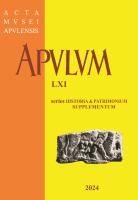NOUTĂȚI DESPRE ÎNTÂIA TIPOGRAFIE ARABĂ DIN MOLDOVA ȘI DESPRE ACTIVITATEA TIPOGRAFULUI DUCA SOTIRIOVICI DIN THASOS
News about the First Arabic Printing House in Moldavia and about the Work of the Printer Duca Sotiriovici from Thassos
Author(s): Policarp ChițulescuSubject(s): History, Cultural history, Modern Age, 18th Century
Published by: Muzeul National al Unirii Alba Iulia
Keywords: typography; Moldavia; Walachia; Duca Sotiriovici; Arab Christians; Patriarch Sylvester;
Summary/Abstract: The special status enjoyed by the Romanian Principalities within the Ottoman Empire, the high intellectual level of the rulers and a consistent financial base allowed the materialization of large-scale cultural initiatives in favor of Orthodoxy. Thus, in the middle of the eighteenth century, in Moldavia, as in Wallachia, among others, printing activity in Arabic and the worship of monasteries to the Patriarchates of the East, in this case, that of Antioch, were supported by the ruling family of the Mavrocordati. At the same time, he became involved in the anti-Latin polemic waged in the East by Arab-speaking Christians threatened by Jesuit proselytizing, supporting Patriarch Sylvester of Antioch, present in Moldova several times. In Iasi, during the reigns Constantine and Ioan Mavrocordat, local private printing workshops were involved in organizing the Arab printing house at St. Sava Monastery. In the proposed material, we will highlight some of the main actors of this approach, who remained unknown until today, but who contributed to the success of the princely project. During the reign in Moldavia of the Mavrocordati brothers, Constantin and Ioan, the only printing workshop in Iasi was that of a Greek printer Duca Sotiriovici from Thassos. It seems that at that time, his printing house was the only functional printing house in the whole of Moldova. Following the analysis of Duca Sotiriovici's Arabic and printed books, we found his involvement in organizing the Arab printing house at St. Sava Monastery. In this topic, we discussed, first of all, the dispersal and reuse of the inventory of the Holy Sepulchre printing house at St. Sava Monastery in Iasi. I showed Duca Sotiriovici's involvement in organizing the Arab printing house at St. Sava, describing the Slavic-Romanian Clock, Iasi, 1743-1746 as a contribution to the Old Romanian Bibliography, a book published near the time of the establishment of the Arab printing house. We proved that Duca Sotiriovici did not stop printing new books after 1752 as all scholars have considered so far, stating that two Greek books: The Apostolic Nets (1756) and Light in the Darkness (1757) justify Duca S.'s purchase of a new letter for his workshop in 1751 and confirm the reality of the renewal of the princely privilege of 1756. Also now, we have described two new Greek titles that are added to the Old Romanian Bibliography: Sinopsis, Iași, 1757 and Ekloge..., The Great Lavra, 1759, thus having a total of 4 new titles, contributions to Old Romanian Bibliography. Therefore, Duca Sotiriovici's list of prints of 12 Romanian and Greek titles + 3 Arabic titles is now joined by 5 new titles, of which 4 represent contributions to the Old Romanian Bibliography. The present study also shows that Duca Sotiriovich was a talented engraver, and new engravings executed by him are now presented; this obviously proves that he was able to execute the set of letters for the Arabic printing house in Iasi and even to make a coat of arms for Patriarch Sylvester of Antioch.
Journal: Apulum
- Issue Year: 61/2024
- Issue No: 1
- Page Range: 79-116
- Page Count: 38
- Language: Romanian
- Content File-PDF

